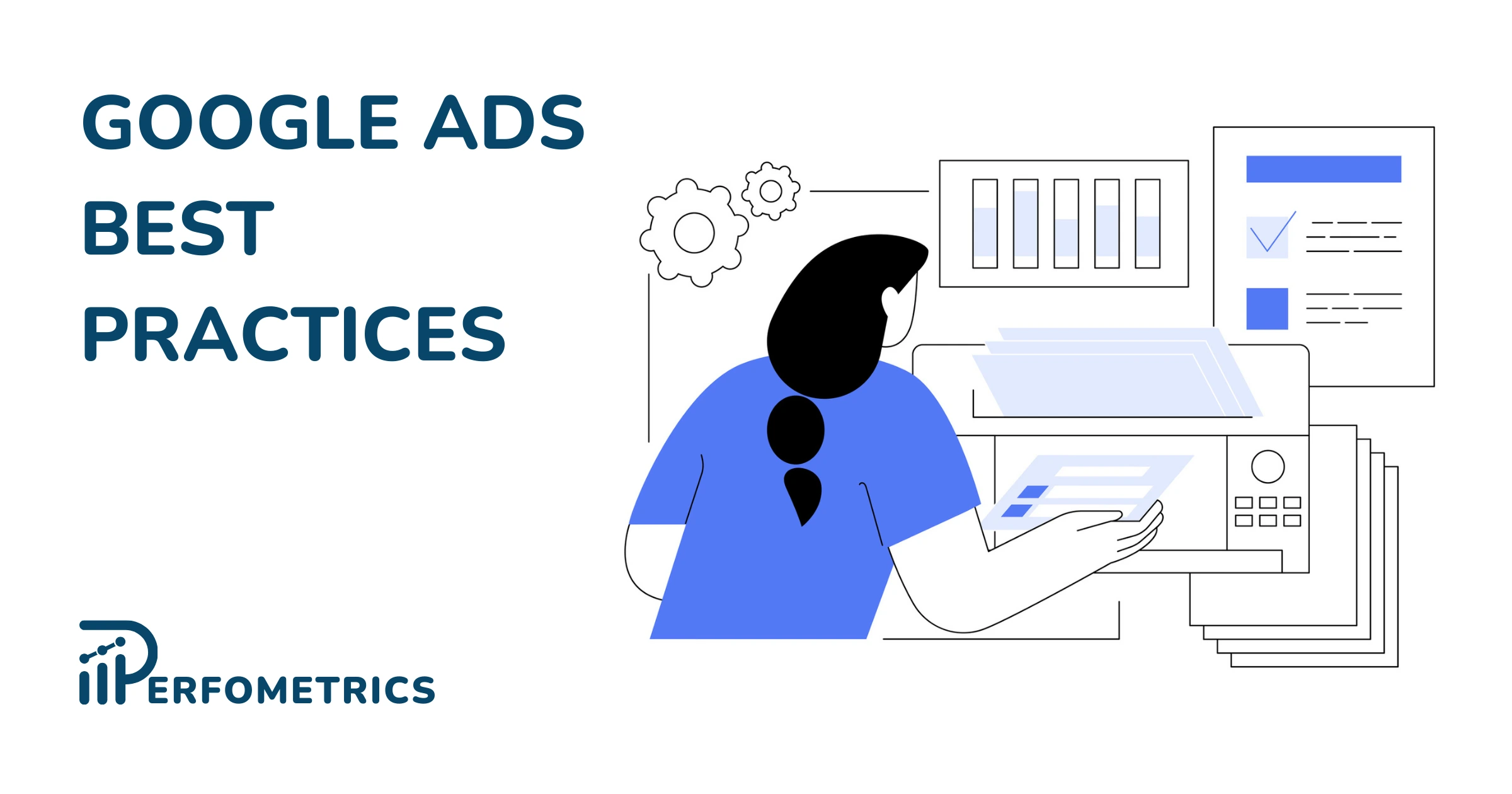Google Ads Best Practices – 8 Steps You Must Complete [Ultimate Guide]

These Google Ads best practices involve a range of strategies and insights you can follow to improve the performance of your Google Ads campaigns and get a better return on investment.
Google Ads is undoubtedly one of the most effective ways to reach potential customers and drive sales. However, with the rising competition, it can be challenging to stand out and get the most out of your ad spend.
We’ll cover some of the most important best practices for Google Ads. These best practices will help you get the most out of your advertising investment and achieve your marketing goals.
Essential Google Ads Best Practices:
1. Establish Your Google Ads Goals Effectively
Before you start creating Google Ads campaigns, it’s important to set goals and key performance indicators (KPIs) to measure your success.
Setting clear goals and KPIs will help you stay focused and make data-driven decisions about your campaigns. What gets measured gets managed.
When it comes to setting goals for your Google Ads campaigns, it’s important to make them SMART: Specific, Measurable, Achievable, Relevant, and Time-bound.
Here’s how that looks in practice:
| Specific | Your goals should be clear and well-defined | Avoid setting vague goals like “increase sales” and instead set specific goals like “increase online sales by 20% over the next six months.” |
| Measurable | Progress should be trackable and quantifiable | “By 20%” is a measurable goal |
| Achievable | Your goals should be challenging, yet achievable | Based on your current resources and capabilities, is it realistic to achieve a “20% increase in sales over the next six months” with Google Ads campaigns? |
| Relevant | Your goals should align with your business objectives | The goal of increased sales is directly related to the business objective of being profitable |
| Time-bound | Your goals should have a specific timeline or deadline | The goal of “20% increase in sales” should be achieved “over the next six months” |
2. Identify Your Ideal Audience in Google Ads
By understanding your target audience, you can create ads and campaigns that resonate with them and drive more conversions.
A good starting point is if you have already defined your buyer personas a.k.a. archetypes that represent different subsets of your customer base. You can also leverage other data you have on your customers, such as data collected via Google Analytics or other analytics tools.
Google Ads offers a variety of audience targeting features, such as demographic targeting, in-market targeting, affinity targeting, and remarketing. By using these features, you can reach specific audiences with your ads and tailor your messaging to their interests and behaviors.
Tip: For a more in-depth dive into this topic read Audiences in Google Ads.
Moreover, to get the most out of audience targeting it’s important to test different audience combinations and see which ones perform best.
By testing different audience targeting options and optimizing your campaigns based on performance data, you can improve your ad relevance and engagement and achieve better results with Google Ads.
3. Choose the Right Google Ads Campaign Type
Each Google Ads campaign type is designed to achieve specific goals, by targeting keywords and/or audiences, and choosing the right one for your business will be key to your success.
Here’s an overview of the 8 campaign types available to you in Google Ads.
But which Google ads campaign type is the right one for you? The right campaign type will be the one that correlates to your specific campaign objective and target audience.
So if you aim to target high-intent customers who are searching for your type of product or service, then Search or Shopping campaigns might be better suited. Meanwhile, if your aim is to drive app downloads, for example, then App campaigns are a no-brainer.
Tip: For a detailed breakdown of all the different campaign types and when to choose which one, read Google Ads campaign types.
Testing new products that Google releases (such as Performance Max campaigns) will also play an important role in staying ahead of the curve and maximizing your advertising efforts.
4. Refine Keywords for Peak Google Ads Performance
One of the most important aspects of successful Google Ads campaigns is the keywords – you just have to be smart about it.
Before you can start targeting keywords, you need to understand the customer funnel. The customer funnel consists of three stages: awareness, consideration, and action.
- The awareness stage is when a customer first becomes aware of your brand or product.
- The consideration stage is when they start to research and compare different options.
- The action stage is when they make a purchase or take a desired action.
Once you’ve identified the customer funnel, you need to identify keywords for each stage. For example, in the awareness stage, customers may be searching for generic keywords related to your industry or product category. In the consideration stage, they may be searching for specific product features or benefits. In the action stage, they may be searching for specific product names or brands.
By matching your keywords to the customer funnel and creating targeted campaigns, you can reach users at the right stage of the buying process and increase your chances of converting leads into customers.
Here are some best practices for keyword optimization in Google Ads:
- Leverage keyword research tools: Google Ads Keyword Planner is a popular keyword research tool, but it’s also important to use other tools like Google Trends, SEMrush, Ahrefs, and Moz to get a comprehensive understanding of search behavior and identify relevant keywords as well as the keywords that your competitors are targeting. This can give you valuable insight into which keywords are driving traffic and conversions in your industry.
- Use negative keywords: An often underrated strategy, but one that can increase the effectiveness of your targeting while ensuring your budget is not being wasted. Negative keywords exclude your ad from showing on specific queries. For example, if you only sell dog food and not food for cats or other pets, you can exclude cat-related terms.
- Group keywords into themes: Grouping keywords into themes based on relevance and search intent can help you create targeted ad groups and ad copy that aligns with the searcher’s intent.
- Continuously review and refine your keyword list: Here you can refer to the search terms report for insights on what users are searching for. Conducting ongoing keyword research and optimizing your keyword list based on performance data is crucial to improving the effectiveness of your Google Ads campaigns over time.
Tip: For more in-depth articles on how to improve your keyword performance, read keyword optimization in Google Ads.
5. Craft Captivating Google Ads Copy
Now it’s time to create ad copy that will entice users to click on your ads and take action on your website.
Here are some best practices for creating compelling ad copy for your Google Ads campaigns:
- Focus on the user: Your ad copy should be focused on the user and how your product or service can solve their problem or fulfill their needs. Use language that speaks directly to your target audience and addresses their pain points. Also, match the messaging to the stage of the funnel the user is in.
- Highlight unique selling points: Use your ad copy to highlight what makes your product or service unique and different from your competitors. This can include features and benefits such as in the case of Mailchimp (i.e. free email templates, free signup forms).
- Use a strong call-to-action (CTA): Your ad copy should include a clear and compelling call-to-action that tells users what action to take next, such as “Shop now” or “Get started”
- Test and optimize your ad copy: Continuously test different variations of your ad copy to see what performs best. Use A/B testing to compare ad copy with other headlines, descriptions, and CTAs. Ads such as responsive search ads are excellent at doing tests automatically.
Don’t neglect the other parts of your ad, such as the creative. Make sure to follow the right image and video formats and use high-quality assets. Here you can refer to the Asset Report to see which assets work best and which ones need to be adjusted or replaced – Google recommends that you always update bad performers.
6. Implement Winning Bidding Strategies in Google Ads
The bidding strategy in Google Ads is a crucial element of a successful campaign. By setting the right bid strategy and budgets for your campaigns, you can control your ad spending, maximize your ROI, and achieve your business goals.
- Be realistic: The first step in effective bidding is defining and understanding your campaign goals – the SMART goals we talk about at the beginning of this blog post. By understanding your goals, you can set realistic bids that will help you reach them. Take into account your overall marketing budget, your campaign goals, and your expected ROI, and set a daily or monthly budget that aligns with your business objectives.
- Utilize bid adjustments: Bid adjustments in Google Ads can help you refine your bidding strategy and make your ads more effective. With bid adjustments, you can customize your bids based on various factors, such as device, location, or audience. This is only applicable to manual bidding, not smart bidding strategies.
- Consider automated bidding: Automated bidding can save you time and improve your bidding strategy. With automated bidding, you can set your bids to adjust automatically based on your goals and performance data. This can help you optimize your bids more efficiently and ensure that you’re getting the most out of your ad spend, such as reaching your target ROAS or target CPA.
- Set up conversion tracking: Conversion tracking in Google Ads allows you to track the actions users take on your website after clicking on your ads, such as making a purchase or filling out a lead form. By tracking conversions, you can better understand which campaigns, keywords, audiences, and ad groups are driving the most valuable actions for your business.
- Monitor and adjust accordingly: Use conversion tracking and other campaign performance data to adjust your bids and budget to focus on the campaigns and keywords that are driving the best results.
7. Maximize Landing Page Impact for Google Ads
A landing page is the web page users are directed to after clicking on your ad. This page plays a critical role in the success of your Google Ads campaigns, or any other marketing efforts.
Here are a few best practices for optimizing landing pages for your Google Ads campaigns:
- Keep it simple: Your landing page should be easy to navigate, have a clear focus, and have a single compelling call-to-action (CTA). Avoid clutter and distractions that could detract from the user’s focus.
- Use social proof: Customer reviews can increase sales conversions by up to 270%. That’s a statistic not to be ignored. Adding social proof elements such as customer reviews, ratings, and testimonials can help build trust and credibility with your audience, leading to more conversions.
- Use high-quality images and videos: Adding high-quality images and videos to your landing page can help grab the user’s attention and communicate your value proposition more effectively.
- Optimize for mobile: Make sure your landing page is optimized for mobile devices, has a responsive design, and fast loading time.
- Test and optimize your landing pages: Continuously test different variations of your landing pages to see what performs best. Use A/B testing to compare landing pages with different headlines, content, and CTAs to optimize your landing pages over time.
8. Track and Improve Google Ads Results
Tracking and analyzing the performance of your Google Ads campaigns is crucial for making data-driven decisions and optimizing your campaigns over time.
Besides the metrics that are related to your SMART goals, here are some key Google Ads metrics you should track and analyze:
| Click-through rate (CTR) | CTR is the percentage of users who click on your ad after seeing it. A high CTR indicates that your ad is relevant and engaging to your target audience. |
| Conversion rate (CVR) | Conversion rate is the percentage of users who complete a desired action on your website, such as making a purchase or filling out a form. A high conversion rate indicates that your landing page and ad copy are effective at driving conversions. |
| Cost per click (CPC) | CPC is the amount you pay for each click on your ad. Tracking your CPC can help you optimize your bidding strategy to get the most value for your advertising budget. |
| Quality score | Quality score in Google Ads is a metric that is used to rate the relevance and effectiveness of your ad and landing page. A high-quality score can lead to lower CPCs and higher ad rankings. |
| Optimization Score | The optimization score in Google Ads reflects how well your account is set up to maximize performance based on Google’s best practices. It ranges from 0% to 100%, with a higher score indicating that your account is more optimized. |
| Return on ad spend (ROAS) | ROAS is the amount of revenue generated for each dollar spent on advertising. Tracking your ROAS can help you optimize your campaigns to generate more revenue and profits. |
| Bounce rate | Bounce rate is the percentage of users who leave your landing page without taking any action. A high bounce rate can indicate that your landing page is not relevant or engaging to your target audience. |
By tracking and analyzing these key metrics, you can identify areas for improvement and optimize your Google Ads campaigns over time to generate more conversions and revenue for your business.
Our Final Thoughts
Running successful Google Ads campaigns requires a combination of best practices, tactics, and strategies.
By setting smart goals, conducting keyword research, optimizing your landing pages, creating high-quality ads, and managing your bidding and budgeting effectively, you can drive better results and achieve your business objectives with confidence.
💡 For more, read: common Google Ads mistakes.



